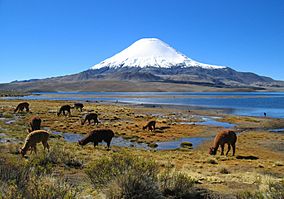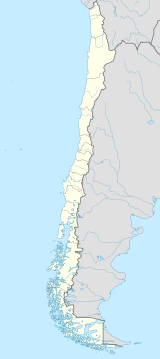Lauca National Park facts for kids
Quick facts for kids Lauca National Park |
|
|---|---|
|
IUCN Category II (National Park)
|
|

Llamas and alpacas at Lauca NP, with Parinacota Volcano in the background
|
|
| Location | Arica-Parinacota Region, Chile |
| Nearest city | Putre |
| Area | 1,379 km2 (532 sq mi) |
| Established | 1970 |
| Visitors | 12,087 (in 2012) |
| Governing body | Corporación Nacional Forestal |
Lauca National Park is a special protected area in Chile, located far up north in the Andean mountains. It's a huge park, covering about 1,379 square kilometers (that's about 532 square miles!). This area includes high plains called the altiplano and towering mountains, many of which are giant volcanoes.
Lauca National Park is part of an even bigger protected area called the Lauca Biosphere Reserve. This reserve also includes the Las Vicuñas National Reserve and the Salar de Surire Natural Monument. The park even shares a border with Sajama National Park in Bolivia.
Contents
Where is Lauca National Park?
This amazing park is found about 145 kilometers (90 miles) east of the city of Arica. It's also just 12 kilometers (7.5 miles) west of a small town called Putre. The park sits at very high altitudes, from about 3,200 meters (10,500 feet) up to 6,342 meters (20,800 feet) above sea level!
You can reach the park by taking Chile Route 11. This road connects Arica to the Tambo Quemado Pass, which is an important border crossing.
What Makes Lauca Special?
One of the most beautiful spots in Lauca National Park is the area around Chungará and Cotacotani lakes. These lakes are nestled at the base of the Payachata volcanic group, which includes two impressive volcanoes. Other majestic volcanoes in the park are the Guallatiri and the Acotango.
Besides the stunning volcanoes and lakes, Lauca National Park also has interesting archaeological sites. You can find ancient ruins, old lava fields, and huge volcanic craters. Inside the park, there's a small town called Parinacota with a very old colonial church that's worth seeing.
The Lauca River also starts its journey within the park. To the west, the Lluta River flows near the park's border.
Animals and Plants of Lauca
Lauca National Park is part of a special natural area called the Central Andean dry puna. This means the plants and animals here are used to living in a very dry, high-altitude environment.
Amazing Animals
The park is home to many different kinds of animals. You might spot mammals like vicuñas, llamas, alpacas, and guanacos, which are all related to camels. Other animals include tarucas (a type of deer), cougars (also known as pumas), and vizcachas (which look a bit like rabbits with long tails).
Lauca is also a fantastic place for birdwatching! There are over 140 different bird species living here. Some of the birds you might see include the puna ibis, Andean goose, giant coot, puna tinamou, silvery grebe, crested duck, puna teal, the mighty Andean condor, and the beautiful Chilean flamingo.
Unique Plants
More than 400 different types of vascular plants grow in Lauca National Park. These plants have special ways to survive in the tough puna environment, with its high altitude and dry conditions. You'll find unique plant communities like bofedales (wet grasslands), llaretales (dense, cushion-like plants), and Andean steppes (grassy plains).
Images for kids
-
Chungará Lake and Sajama stratovolcano
See also
 In Spanish: Parque nacional Lauca para niños
In Spanish: Parque nacional Lauca para niños




